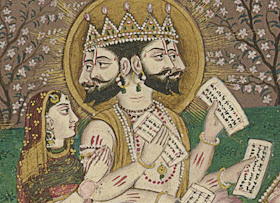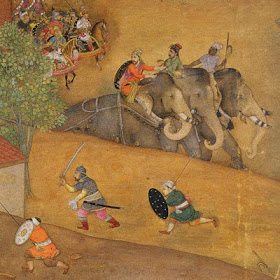Tuesday, May 31, 2011
Saturday, May 28, 2011
Thursday, May 26, 2011
Wednesday, May 25, 2011
Young Maharana
Young Maharana, probably Raj Singh II, from the Small Clive Album. Mughal period, 16th-18th century.
In cold climates, people tend to like paintings with blue sunny skies; but in India, dark monsoon rain clouds are welcome relief from the long dry season, and are considered auspicious, hence their frequent appearance in Indian miniatures.
Monday, May 23, 2011
Sunday, May 22, 2011
Gold
The gold embellishment on the couple's clothing and jewellery has come up well in this photograph. Gold can be applied in the form of gold leaf adhered with gilding size (glue), or painted on in liquid form (gold dust mixed with gum arabic).
Saturday, May 21, 2011
Friday, May 20, 2011
Sunday, May 15, 2011
Saturday, May 14, 2011
Rembrandt's Indian Phase
Rembrandt was fascinated by Indian miniature paintings, and made numerous drawings after originals. Read more.
Friday, May 13, 2011
Drawing
The initial stage of an Indian miniature painting is the drawing. In the past, charcoal was used to outline the image and this was then traced over in somewhat feint watercolour, usually of a reddish-brown colour, using a fine brush. The neutral reddish-brown tint is suitable for most objects, and particularly good for outlining skin tones in figures. These days, a graphite ('lead') pencil is often easier to use than charcoal. A medium hardness 2B pencil, which is soft enough not to engrave the paper, but hard enough to keep a sharp point. For very fine drawing, a harder pencil may be required. While doing the brush drawing (tracing over the pencil lines with watercolour), corrections can be made to the pencil drawing if necessary. After the watercolour outline has dried, a soft eraser can be used to gently remove traces of pencil marks that are still visible. Drawing as lightly as possible with the pencil makes erasure easier. Graphite has a slight disadvantage over charcoal in that it is less absorbent and does not take the brush drawing as well as charcoal. If the graphite line is too thick, the watercolour tends to bead on top of it.
During the next stage - blocking in colour within the outlines - corrections may be made if parts of the outline seem too heavy and thick, by slightly overlapping the outline with the body colour.
Finally, sometimes a third layer of outline, in a more saturated colour, is needed to sharpen up the image. Care should be taken not to be heavy-handed or the delicate life of the image may be destroyed - a very fine brush is used.
Varying the weight or thickness of lines, and even breaking them slightly here and there, adds energy to the outlines and allows the images to 'breathe'. Though miniature painting is a very precise artform, the calligraphic expression of the drawing should still be evident in the final painting to a certain extent.
The fine Mughal-style brush drawing above, from the Victoria and Albert Museum collection, is probably a study rather than an outline for a painting, as the paper does not appear to have been prepared for a coloured miniature.
The fine Mughal-style brush drawing above, from the Victoria and Albert Museum collection, is probably a study rather than an outline for a painting, as the paper does not appear to have been prepared for a coloured miniature.
Tuesday, May 10, 2011
Sunday, May 8, 2011
Saturday, May 7, 2011
Friday, May 6, 2011
Thursday, May 5, 2011
Materials and Technique
To reproduce the style of traditional Indian and Persian miniatures, I use gouache paints, sometimes with the addition of watercolour paints. Gouache is similar to watercolour but much more opaque. It dries quickly and has a matte finish. The brilliance and matte finish of gouache makes it suitable for Indian miniature painting.
I use the best quality gouache paints possible on thick, acid-free watercolour paper with a smooth surface. The Winsor and Newton gouache range is good. Their website has tips on gouache technique. Here's a link: www.winsornewton.com
Some artists report that M. Graham and Schminke artist’s gouache are the very best to paint with, and are not too much more expensive than W&N. You might have to mail order these brands. I have yet to try these, but probably will soon, and I'll try to review them in a post.
Gouache paints vary in opacity and drying time. I have had problems with certain white cheap gouache paints remaining sticky for a long period. Because most gouache colours dry very quickly, you can get caught off guard and ruin a painting by transferring the tacky paint on your hand.
Gouache and watercolour are thinned with water, which tends to cause the paper support to buckle. Painting in fine detail on a bumpy surface is not ideal so I generally stretch the watercolour paper by wetting it and taping or pinning it to a board. As the paper dries, it becomes taut, and buckling is greatly reduced. The thicker the paper, the less this is a problem. Historically, paper for miniatures was sealed, presumably with some kind of gum arabic mixed with white, and this would have prevented water from the paints distorting the paper. Buckled paintings can be flattened under heavy books, once they have dried, although a severely buckled piece of paper can get creased in an attempt to flatten out the bumps. If a totally stable surface is desired, a stiff support such as illustration board is an option.Wednesday, May 4, 2011
Copper Green
Copper green (verdigris) was a favourite background colour in Mughal paintings. It was perfect for setting off the warm colours in figures and flowers. I've read that this particular turquoise-like green was made from oxidised copper. This seems correct as the colour resembles that of oxidised copper roofs. Unfortunately the pigment is destructive to paper over time, especially if the painting is stored in a humid environment. There are probably modern equivalents of this pigment that are not corrosive but I have never seen them in art supply shops, at least not in the form of gouache or watercolour paints. I have a tube of oil paint which is similar in colour. I would be very grateful if any readers have discovered a paint manufacturer of this colour suitable for miniature painting on paper. I think verdigris is no longer made by paint makers, because of its instability and toxicity but I would be interested to know which modern equivalent is closest in appearance to verdigris.
The name verdigris comes from French Vert de Grece (green of Greece).
The name verdigris comes from French Vert de Grece (green of Greece).
Image source: Victoria & Albert Museum
This colour (Cobalt Turquoise) is the closest I can find in the Winsor and Newton Designer Gouache range:
As you can see, it's not really the same. Maybe adding yellow and white might produce something closer.
Update: I've been doing a bit of research.
According to Dick Blick Art Supplies, Phthalo Green (polychlorinated copper(II) phthalocyanine) is the pigment which most closely resembles the discontinued and toxic Verdigris. Here's a link to their information: dickblick.com/phthalo green gouache
In the W&N range this pigment is called Winsor Green.
naturalpigments.com supply a copper green made from naturally occurring malachite, a mineral formed from copper carbonate hydroxide. It's supposedly quite permanent - apparently it was used in Egyptian wall paintings and is still brilliant after thousands of years.
More information about natural malachite pigments: natural pigments.
Powdered malachite is hazardous if inhaled or ingested, in a paint form it should be safe as long as you don't have a habit of licking your brush, and wash thoroughly if the paint contacts the skin.
Apparently the finer ground pigments are lighter in shade, which is possibly what was used in the best quality Indian and Persian miniatures.
In the W&N range this pigment is called Winsor Green.
naturalpigments.com supply a copper green made from naturally occurring malachite, a mineral formed from copper carbonate hydroxide. It's supposedly quite permanent - apparently it was used in Egyptian wall paintings and is still brilliant after thousands of years.
More information about natural malachite pigments: natural pigments.
Powdered malachite is hazardous if inhaled or ingested, in a paint form it should be safe as long as you don't have a habit of licking your brush, and wash thoroughly if the paint contacts the skin.
Apparently the finer ground pigments are lighter in shade, which is possibly what was used in the best quality Indian and Persian miniatures.
Elijah
The prophet Elijah rescuing Hamza's nephew, Prince Nur ad-Dahr. Mughal dynasty, AD 1562-77, India.
Source: British Museum
Source: British Museum
Bhairavi Ragini
Bhairavi Ragini from the Manley Ragamala. Probably Amber, Rajasthan, India, Sub-Imperial Mughal style, around AD 1610.
























